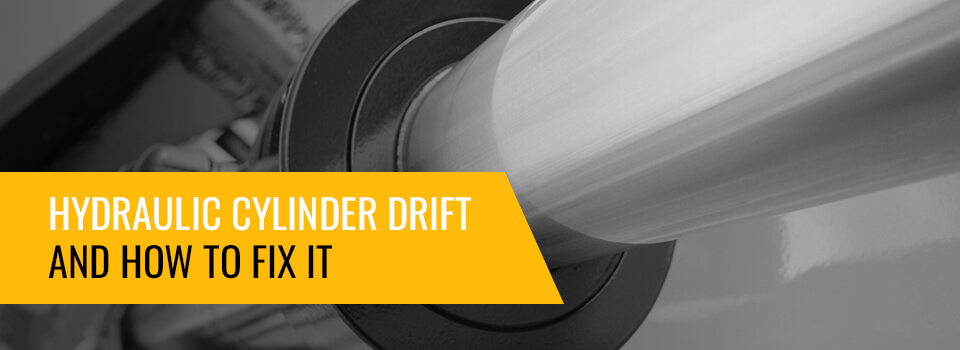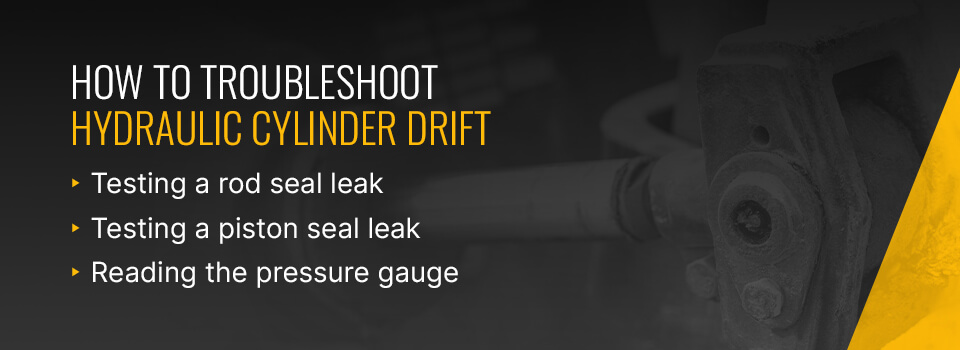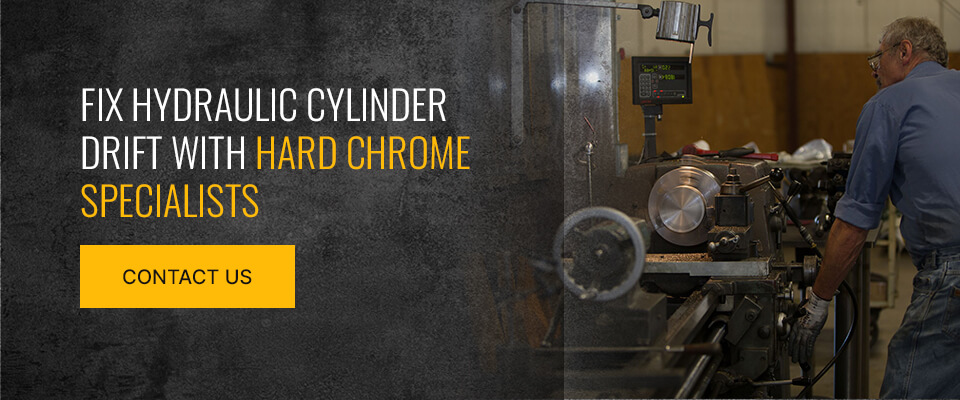Hydraulic Cylinder Drift Prevention

Hydraulic Cylinder Drift
Hydraulic cylinder drift is an issue that occurs between the piston, rod and oil pressure of a cylinder. When a seal breaks and fluid begins to leak, it causes an equalized amount of pressure above and below the piston throughout the cylinder tube. Under normal circumstances, pressure levels fluctuate depending on a machine’s movements. With equalized oil pressure inside the hydraulic cylinder, you’ll experience drift.
Hard Chrome Specialists deliver hydraulic cylinder repairs when your heavy equipment fails. Our experts repair cylinders and components to new condition, to ensure extended lifetime and avoid costly downtime. If hydraulic cylinder drift is an issue, we have you covered.
Explore the Rest of Our Hydraulic Systems Guide:
What Is Hydraulic Cylinder Drift?
During a hydraulic cylinder’s normal movement, a rod and piston inside the cylinder will change the volume of fluid. The cylinder compresses the fluid or oil to create consistent pressure via seals that prevent leaks. When you adjust your equipment at various positions, the cylinder won’t move, which is known as hydraulic lock.
However, hydraulic cylinder drift is when the cylinder physically “drifts” or moves downward while you’re operating heavy machinery. It can cause the cylinder to slowly sink while holding a heavy load of material, or the cylinder can operate with unusual movements. Drift makes your articulations sluggish and unable to hold loads over a period no matter the weight.
It can be a challenge for hydraulic systems in various pieces of equipment like excavators, aerial lifts, cranes and backhoes, resulting in unsafe work environments and lower productivity levels. But the troubleshooting process is simple and replacement parts are a quick fix to the issue. You can also take several proactive steps to prevent hydraulic cylinder drift in the future.
Common Signs of Hydraulic Cylinder Drift
The quicker you can recognize signs of hydraulic drift, the faster you can diagnose the cause and make replacements. Common signs of drift include:
- Jerky hydraulic movements
- Uneven distribution of force on the equipment
- Cylinder slowly moves downward when lifting materials
- Excessive oil leaks
When working with loads of material, especially those weighing several tons, rough movements or “stick slip” can become a serious safety hazard for equipment operators and other ground workers. If hydraulic fluid is uneven, it can affect the distribution of forces and pressure put on an area of the machine causing it to fail.
This is another major safety concern when lifting, transporting and holding various materials. With increased strain on the cylinder’s components, it can cause total failure and costly replacements.
One of the tell-tale signs your equipment is experiencing hydraulic cylinder drift is when the cylinder slowly moves downward like it’s losing energy or pressure. While oil leaks aren’t always attributed to drift, they can be a culprit you always need to address.
What Causes Hydraulic Cylinder Drift?
So, what causes a hydraulic cylinder to drift? An internal leak within the cylinder can cause hydraulic fluid to move across the piston, resulting in unequal pressure and an imbalance of oil flow. Without consistent and even levels of pressure, the cylinder can drift, losing its ability to lock in place. Leaks can come from worn rod seals, holding valves or piston seals.
Causes of hydraulic cylinder drift can be rust, dirt, other fluids and water contaminating the oil creating the wrong viscosity and a rougher flow of fluids. With foreign substances changing the density of the oil, it can sometimes leak past the seals. Aside from contaminated fluid, other components can cause leaks within the hydraulic cylinder, such as:
- Overheating: Overheating can affect the properties of individual seals while increasing wear and tear.
- Poorly rebuilt system: Without correct replacement parts and seals, the hydraulic cylinder can face many issues.
- Improper fluid: Make sure to check your OEM manual to ensure you’re working with the best oil and other fluids for the machine to avoid hydraulic failure.
When the system’s rod seals, piston seals or holding valves begin to fail, the hydraulic cylinder can no longer remain stable and achieve hydraulic lock:
- Rod seals: This is the most common part to fail but also the easiest to detect. A rod seal should keep the oil pressure stable when the rod stops, but when it begins to leak, it can cause drift and leak fluid outside of the cylinder system.
- Piston seals: When piston seals leak, equalized pressure on both sides occurs, which exceeds the pressure relief valve’s limits. This can cause cracks and leaks within the system leading to hydraulic cylinder drift.
- Holding and pressure relief valves: Holding valves, or flow valves, control the hydraulic fluid rate entering the cylinder. When damaged, an imbalance of pressure occurs that can sometimes cause the equipment to not work. Pressure relief valves keep internal pressure at a normal range, but a leaky valve can cause damaged seals and drift.
Diagnosing drift can be done through a hydraulic cylinder drift test. It’s a controlled test that pressurizes the cylinder and works with both rod and piston seals. Start by filling the cylinder with hydraulic oil in the extend and retract ports. Making sure the cylinder is on a flat surface and the end ports are pressurized with a relief valve, you can identify any leaks around the seals. You can also check the pressure gauge to help you determine the issue.

Here’s how to troubleshoot hydraulic cylinder drift:
- Testing a rod seal leak: The piston rod will immobilize as pressure equalizes in the cylinder.
- Testing a piston seal leak: A leaking piston seal may not always be the direct cause of drift. If the cylinder is full of oil and the ports are intact, it’ll maintain pressure unless the rod seals leak.
- Reading the pressure gauge: If you can’t detect any fluid leaks, you can check the cylinder’s pressure gauges to diagnose drift. If there is increased pressure on the rod side, piston pressure will increase to maintain the load. Check the rod and piston pounds per square inch levels to evaluate.
The solution to hydraulic cylinder drift is to replace faulty seals and valves while ensuring the system isn’t overheating and you’re working with the right oil and parts for your machine. Two situations where hydraulic lift won’t be an issue are if you have double rod cylinders or double acting cylinders.
Best Ways to Prevent Hydraulic Cylinder Drift
The best way to prevent hydraulic cylinder drift is through regular maintenance. Whether you’re in the marine, pharmaceutical, manufacturing or construction industry, maintaining your equipment is key.
It should be part of your routine to check the components of each machine in your fleet, including the hydraulic cylinders and their seals and fluids. Look for corrosion, examine the rods, inspect the mount and pin condition, check for leaks and look for general wear and tear. It’s also important to use top-quality filtration systems and monitor load capacity levels and speeds while working.
Once you see signs of cylinder drift, diagnose the issue immediately. Is the culprit a leaking piston valve or rod valve? Is the machine operating with contaminated oil? Replacing parts and fluids right away will help prevent more severe and costly damage later on and reduce downtime.
Cylinder drift cause and prevention also come down to working with a purpose-built cylinder. While generic solutions can get the job done, you’ll want to invest in a part that matches the make and model of your machine and application. Install a cylinder that’s built specifically for the equipment so it can perform at its highest level and last long-term. Purpose-built cylinders are more efficient and less prone to failure.
Fix Hydraulic Cylinder Drift With Hard Chrome Specialists
With our expertise in hydraulic cylinder repairs and exceptional commitment to honest service, you can rely on us to repair your system within quick turnaround times. Proper cylinder maintenance is crucial for efficient and safe operations, but when components finally wear, we have ISO-certified solutions to keep you and your crews safe while preventing downtime.
Contact us if you’re looking for expert support or learn more about our cylinder repairs.

